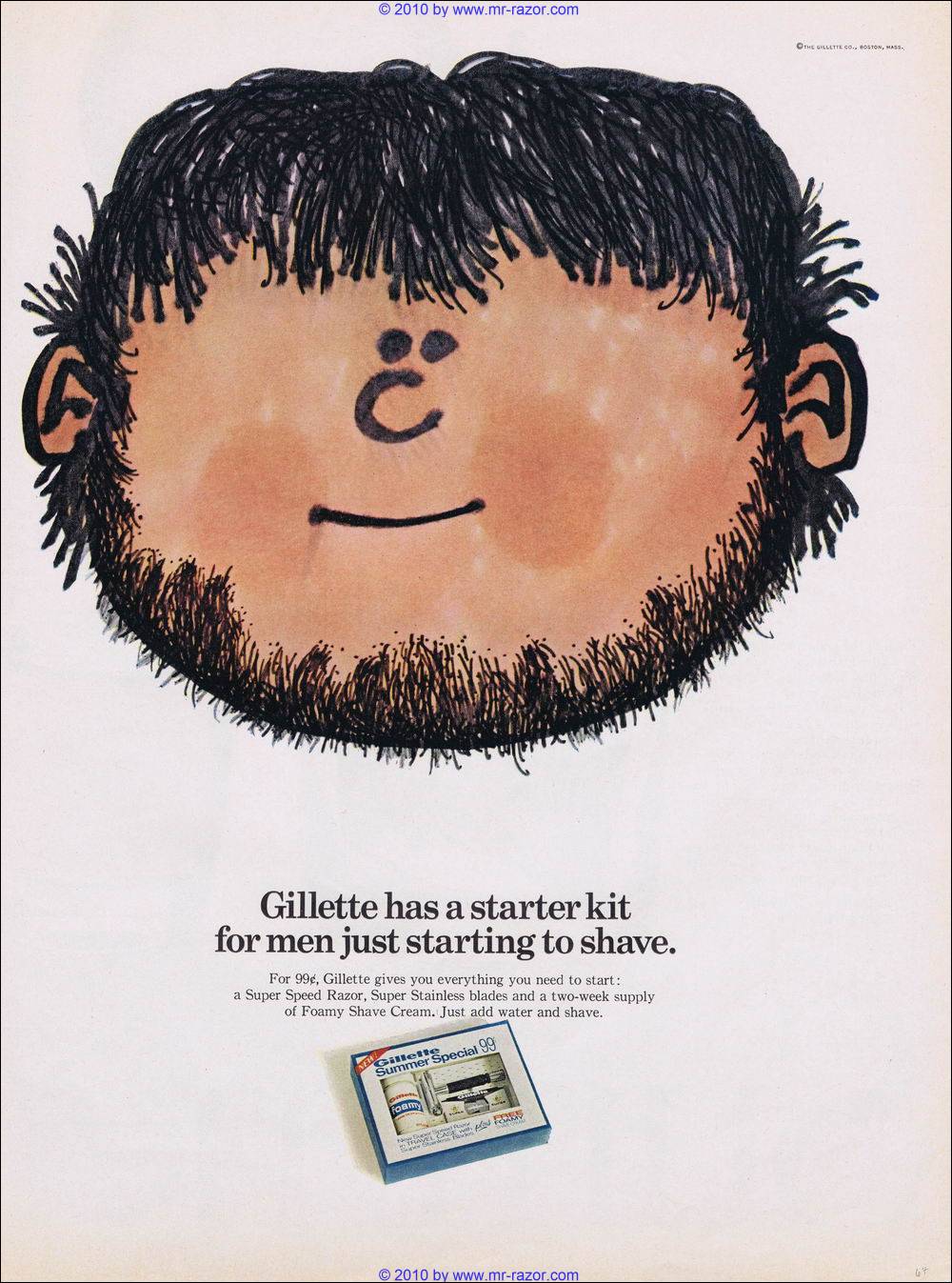how Gillette pitched the early 1950's aluminum black plastic handled SS. to the public. I doubt they went with the "this material saves us money" campaign.
You are using an out of date browser. It may not display this or other websites correctly.
You should upgrade or use an alternative browser.
You should upgrade or use an alternative browser.
I would be interested to know..............
- Thread starter Mr.K
- Start date
Not sure if this is what you're looking for but, here's an old commercial showing the Gillette Super Speed Light:
http://www.youtube.com/watch?v=H-gmoyG2PT8&feature=player_embedded
To quote the commercial: "Light for sensitive skin and younger men..."
http://www.youtube.com/watch?v=H-gmoyG2PT8&feature=player_embedded
To quote the commercial: "Light for sensitive skin and younger men..."
- Thread starter
- #3
Not sure if this is what you're looking for but, here's an old commercial showing the Gillette Super Speed Light:
http://www.youtube.com/watch?v=H-gmoyG2PT8&feature=player_embedded
To quote the commercial: "Light for sensitive skin and younger men..."
Thanks, but I believe that was for the blue tip model.
Ahh ok, wasn't sure which Super Speed they were advertising. It would be interesting to find the advertisement through.
From Mr. Razor


and here is the set from the Ad:

- Thread starter
- #7
that's a much later razor. I'm referring to the 1951 (W) Super Speed that was marketed in conjunction with the all nickel handle. Some SS of this era had an aluminum handle, black plastic knob at the bottom and a regular SS head.
Sorry but I can't post pictures.
Thanks,
Evan.
Ahh, here's a link and picture:
http://badgerandblade.com/vb/showthread.php?p=2469677&highlight=Aluminum+Super+speed#post2469677
Sorry but I can't post pictures.
Thanks,
Evan.
Ahh, here's a link and picture:
http://badgerandblade.com/vb/showthread.php?p=2469677&highlight=Aluminum+Super+speed#post2469677
Last edited:
No mention of materials.


I'm sure that they didn't acknowledge the change in materials at all, expect maybe to point out how 'modern' the new razors were.
They may not have advertised that it saved them money but I am sure they advertised that is was less expensive for the customer if it was, or that it was light weight space age materialshow Gillette pitched the early 1950's aluminum black plastic handled SS. to the public. I doubt they went with the "this material saves us money" campaign.
- Thread starter
- #11
They may not have advertised that it saved them money but I am sure they advertised that is was less expensive for the customer if it was, or that it was light weight space age materials
Do we know what the price difference was? Any a old print advertising comparing the two?
Perhaps it was just a cheaper option for the consumer.
The cavalcade of sports set from the year before was also $1.
I looked in Google Books and all the ads for the black tip ads focus on the new styrene case that opens easily.....
Here is another one more clearly showing the black tip in the illustration
http://books.google.com/books?id=3Y...&resnum=3&ved=0CDQQ6AEwAg#v=onepage&q&f=false
Here is another one more clearly showing the black tip in the illustration
http://books.google.com/books?id=3Y...&resnum=3&ved=0CDQQ6AEwAg#v=onepage&q&f=false
Is it an assumption that aluminum and plastic was cheaper in 1950? Metal was a lot more common than plastic things. As a youngster in the 50s, pretty much all my toys were either metal or wood. I would think that aluminum, at that stage of the game, wasn't yet considered by the average consumer as a "lesser, cheaper metal". I'm thinking particularly of aircraft. Public travel on planes was really limited compared to today.
An aside on plastic. Yes, we had bakelite and cellu...? and other materials like that in 1950, but for those familiar with the mid-1960s Dustin Hoffman movie "The Graduate", on the week "Benjamin" graduated from college, one of his dad's well-heeled buddies took Ben aside and offered this advice:
"Just one word, Benjamin. Plastics!"
This in a modern, up-to-date flick channeling the 1960s.
An aside on plastic. Yes, we had bakelite and cellu...? and other materials like that in 1950, but for those familiar with the mid-1960s Dustin Hoffman movie "The Graduate", on the week "Benjamin" graduated from college, one of his dad's well-heeled buddies took Ben aside and offered this advice:
"Just one word, Benjamin. Plastics!"
This in a modern, up-to-date flick channeling the 1960s.
- Thread starter
- #15
Is it an assumption that aluminum and plastic was cheaper in 1950? Metal was a lot more common than plastic things. As a youngster in the 50s, pretty much all my toys were either metal or wood. I would think that aluminum, at that stage of the game, wasn't yet considered by the average consumer as a "lesser, cheaper metal". I'm thinking particularly of aircraft. Public travel on planes was really limited compared to today.
An aside on plastic. Yes, we had bakelite and cellu...? and other materials like that in 1950, but for those familiar with the mid-1960s Dustin Hoffman movie "The Graduate", on the week "Benjamin" graduated from college, one of his dad's well-heeled buddies took Ben aside and offered this advice:
"Just one word, Benjamin. Plastics!"
This in a modern, up-to-date flick channeling the 1960s.
Agreed. How did Gillette market both at the same time? What differences did they use to market both? Price points etc. And why?
I understand the marketing between a blue tip vs. red tip, but I don't get this particular distinction.
Looks like they "pitched" it to the public with an ad featuring a baseball pitcher.
Similar threads
- Replies
- 93
- Views
- 5K
- Replies
- 8
- Views
- 3K
- Replies
- 36
- Views
- 2K
